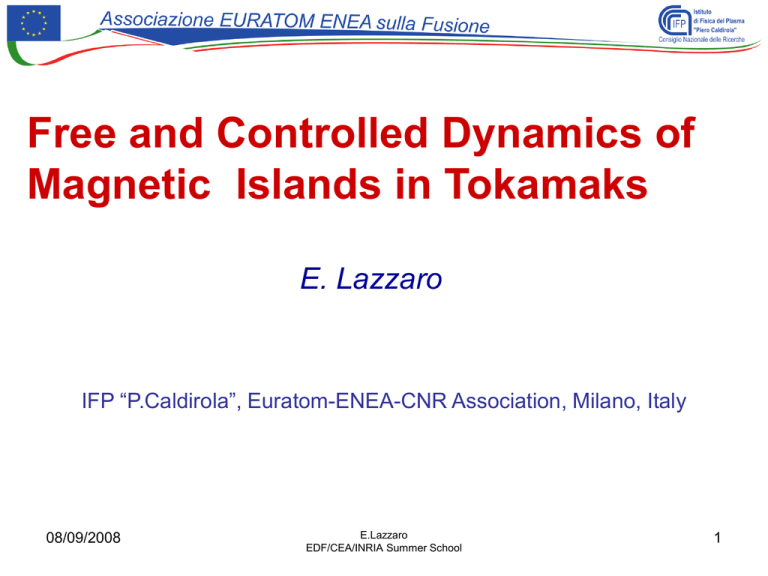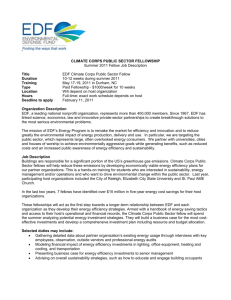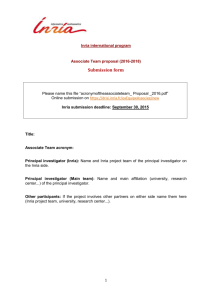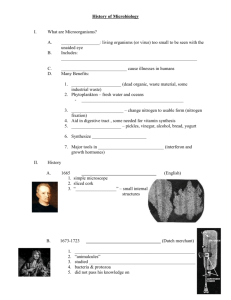Document
advertisement

Free and Controlled Dynamics of Magnetic Islands in Tokamaks E. Lazzaro IFP “P.Caldirola”, Euratom-ENEA-CNR Association, Milano, Italy 08/09/2008 E.Lazzaro EDF/CEA/INRIA Summer School 1 Outline • Brief reminder of tokamak ideal equilibrium • Nonideal effects:formation of magnetic island in tokamaks through magnetic reconnection • Classical and neoclassical tearing modes • Useful mathematical models of mode dynamics • Problems and strategies of control by EC Current Drive • Recent results from of experiments (FTU,ASDEX,DIII-D tokamaks) 08/09/2008 E.Lazzaro EDF/CEA/INRIA Summer School 2 Motivation and Objectives • The reliability of Plasma Confinement in tokamaks is limited by the occurrence of MHD instabilities that appear as growing and rotating MAGNETIC ISLANDS LOCALIZED on special isobaric surfaces and contribute to serious energy losses and can lead to DISRUPTION of the tokamak discharged. • They are observed both as MIRNOV magnetic oscillations and as perturbations of Electron Cyclotron Emission and Soft X-ray signals • They are associated with LOCALIZED perturbation of the current J ,e.g. J bootstrap • Is it possible to stabilize or quench these instabilities by LOCALIZED injection of wave power (E.C.), heating locally or driving a noninductive LOCAL current to balance the Jboot loss? 08/09/2008 E.Lazzaro EDF/CEA/INRIA Summer School 3 Tokamak magnetic confinement configuration The most promising plasma (ideal) confinement is obtained by magnetic field configurations that permit a magnetoidrostatic balance of fluid pressure gradient and magnetic force J B grad p rotB 0 J div B 0 Since B p 0 the isobaric surfaces (p=nT) are “covered ergodically” by the lines of force of B and since B 0 the nested surfaces are of toroidal genus The B field can be expressed through the the magnetic flux (R ) through a poloidal section and (F(R,Z))through a toroidal section Superficie poloidale Superficie toroidale B BT B p F ( ) 08/09/2008 E.Lazzaro EDF/CEA/INRIA Summer School 4 Non ideal effects Helical Perturbations 08/09/2008 E.Lazzaro EDF/CEA/INRIA Summer School 5 Overview of basic concepts • Tokamaks have good confinement because the magnetic field lies on isobaric surfaces of toroidal genus •The B field lines “pitch” dd BB q(0 ) is constant on each nested surface •(Isobaric) magnetic surfaces where q()=m/n have a different topology: there are alternate O and X singular points that do not exist on irrational surfaces: axisymmetry is broken and divB=0 allows a Br component •If current flows preferentially along certain field lines, magnetic islands form •The contour of the island region is an isobar (and isotemperature) • As a result, the plasma pressure tends to flatten across the island region, (thermal short-circuit) and energy confinement is degraded 08/09/2008 E.Lazzaro EDF/CEA/INRIA Summer School 6 Tokamak equilibrium and helical perturbations • • Tokamak Equilibrium Magnetic field in terms of axisymmetric flux function B0 B0 e e 0 ( r ) 1° Force equilibrium J 0 B0 cp • • Field line pitch : d B q( 0 ) d B Helically perturbed field B B0 ( r, ) B1 r, B1 e ~( r, t ) cos , m n • 2° Equilibrium condition (local torque balance) J B 0 B J J B J 0 B1 J1 B 0 B 0 J1 B1 J 0 J 0 B1 J1 B 0 0 • To order(r/R) 08/09/2008 J 0 E.Lazzaro O( 2 ) B 0 J B 1 1r EDF/CEA/INRIA Summer School r 7 Vanishing in axisymmetry Basic Formalism of evolution equations • Reduced Resistive MHD Equations: from vector to scalar system • • Compressional Alfven waves are removed Closure of system with fluid equations 1 E 1 A c t E c t B F B A 4 2 1, A 4 J 2A J c c J // J 0 B J 0 B O (1) : B , m , • Ordering Filters physics 08/09/2008 O ( ) : r R , B ,V , J , t , // O ( 2 ) : B1 ,Vr , J , Acomp R S R A 1E.Lazzaro EDF/CEA/INRIA Summer School 8 • In Ideal MHD Plasma Magnetic topology is conserved B V B t Ideal and Resistive MHD • B is convected with V • Magnetic field diffuses relative to plasma topology In Resistive MHD B c 2 2 V B B t 4 • The evolution of linear magnetic perturbations B˜ is B˜ c 2 2 ˜ ˜ B 0 b V B t 4 ik (x )0 // • Topology can change through reconnection of field lines in a “resistive” layer where • • • k // (x) 0 Resistive MHD E V B/c J removes Ideal MHD constraint of preserved magnetic topology allowing possible instabilities with small growth rates Key parameter 08/09/2008 S R A cr 2VA 4R ~ 10 5 10 8 E.Lazzaro EDF/CEA/INRIA Summer School 9 Essential physics of tearing perturbations • • Quasineutrality constraint J 0 J // B J B First order perturbation J // J // J B B 1 1 B 0 B 1 line bending • • • J1 0 ion inertia kink Competition of a stabilizing line bending term and a kink term feeding instabilities: perpendicular current may alter balance, through ion polarization current and neoclassical viscosity c c d c J 2 B p 2 B (VE Vp i ) 2 B B B dt B diamagnetic Inertia,ion polarization neoclassicalviscosity GGJeffect current enhanchced polarization wdependent! Tearing layer width is determined by balancing inertial and parallel current contributions to quasineutrality R ~ r (mS) 2 / 5 The time evolution of the perturbations is governed by Faraday law and generalised forms of Ohm’s law, including external non inductive contributions 08/09/2008 b A E.Lazzarob E b J J J cb E b c b CD EDF/CEA/INRIA Summer School t 10 Current driven tearing modes physics Boundary Layer problem Outer region - marginal ideal MHD - kink mode. The torque balance requires: B J // B * ( 4c 2 * ) 0 q(r)=2 2 * F ( * ) 1.5 A linear perturbation is governed by an equation that is singular on the mode rational surface where k·B = 0 0 h =0 1 s ˜ F * ˜ ˜ dF drd* dr 2 1 ˜ 2 4 c 0.5 ˜ /B [1 nq /m] J0z 0 0 0.2 0.4 0.6 1 r/a 0.8 Singularity at q=m/n !! Solved with proper boundary conditions to determine the discontinuity of the derivative ' out 08/09/2008 1 d | dx s: reconnected helicalflux E.Lazzaro EDF/CEA/INRIA Summer School 11 Current driven tearing modes physics • The discontinuous derivative equivalent to currents, localised in a layer across the q=m/n surface, where ideal MHD breaks down d 2 dr 2 l d dr •Ampere’s law relates the B perturbation to the current perturbation. For long, thin islands, it can be written: l 1 d 2 B ( B) 4 J|| R dr 2 B c •Integrating this over a period in x and out to a large distance, l, from the rational surface (w<<l<<rs) gives: 4 (w,S, ) ˜ s dx dJ // cosm in c x r rs •Inner region - includes effects of inertia, resistivity, drifts, viscosity, etc Linear Dispersion relation: Linear Growth rate: 08/09/2008 out ( A, J0// (rs )) in (, R,) 2/5 m2 / 5 4 / 5 rq [rsout ] E.Lazzaro 3/5 2/5 qSummer School R A EDF/CEA/INRIA 12 Geometry & Terminology • • • • • • B contours of constant helical flux x 2L ~ cos magnetic shear length L qq' rR cylindrical safety factor q(r) RrBB island instantaneous phase (t) m n w(t')dt' x=r-rs slab coordinate from rational surface q(rs)=m/n w B helical flux reconnected on the rational surface 16 L integrals L dx L(x, )d and averages L L(x, )d on island * 2 s s 2 s s 0 t 0 2 s s d x 13 Neoclassical Tearing Modes (NTM) • In a tearing-stable plasma (0’<0) • Initial island large enough to flatten the local pressure • => loss of bootstrap current inside the island sustains perturbation • Instability due to local flattening of bootstrap current profile • Typically islands with m/n: 2/1 or 3/2 periodicity Can prevent tokamaks from reaching high 08/09/2008 E.Lazzaro EDF/CEA/INRIA Summer School 14 Summary of RMHD equations Resistive-neoclassical MHD fluid model n nV b V// i J // e 0 t dV//iB n B p B s 0 nV 0 dt t s dV 1 J B p s V B 0 2 dt B s B F B A J // B A J 0 ,1 B J0 4 2 J // 1 A E c c t 1 1 1 1 1 1 E V B J J // // b b p e b e p e cR t en en e e en e en e c dV 1 i J B p 0 s 2 B dt s 08/09/2008 E.Lazzaro EDF/CEA/INRIA Summer School 15 Mechanism of bootstrap current Bootstrap Current c dp Jb B dr Constant on magnetic surfaces Generalised parallel Ohm’s law with electron viscosity effects 1 1 1 0 Electron viscous stress damps the poloidal b p e b // e J // c t en en electron flow - new free energy source. electron viscosity bootstrapcurrent c dp b //e meneV e (1 )J // B dr 1 trapped particle bootstrapcurrent 08/09/2008 V e c B pe pi V e V i enB r B effect E.Lazzaro EDF/CEA/INRIA Summer School 16 The NTM drive mechanism Consider an initial small “seed” island: Perturbed flux surfaces; lines of constant W Poloidal angle •An initial perturbation( Wseed) leads to the formation of a magnetic island • The pressure is flattened within the island at the O point, not at X point Pressure • Thus the bootstrap current is removed inside the island Pressure flattens across island • This current perturbation amplifies the magneticfield perturbation,i.e. the island Minor radius 08/09/2008 E.Lazzaro EDF/CEA/INRIA Summer School 17 Construction of the nonlinear island equation • • • 1-A nonlinear averaging operator over the helical angle =m-nwt makes // 0 2-The parallel current is obtained solving the current closure (quasineutrality) equation ,averaging and and inserting it in Ampere’s law 1 J B B J I J p J // J nc B // // J // J // J nc J nc J CD c R R 2 4 R.F.Current drive • “neoclassical” currents Grad-Shafranov equation 3-Averaging Faraday law and eliminating <J//> gives ~ 1 s c cos R R 2 J nc J nc J CD c t 4 • • 4-An integration weighted with cos,over the radial extent of the nonlinear reconnection layer (island ), one obtains the basic Rutherford Equation for W(t) = 4(Br rs / B nq/)1/2 dW 4 R rs dt 08/09/2008 ˜ s(W) rs(W); E.Lazzaro EDF/CEA/INRIA Summer School dx dJ // cos c 18 Modified Rutherford Equation NTM evolution (Integrating Faraday-Ampere on island) 4g1 dw rs2 ['0 'bs 'GGJ ' pol 'EC Re 'wall ] g dW cos d /W / 0.82 dt r geom. factor 2 1 1 w 0 m 1 (de)stabilising w s ' rs Lq w Rax L p w 2 ws2 ' BS aBS p GGJ ' factor, <0 in NTM (# TM) Lq q /q', Lp p / p', ws / // rs 2 Lq Lq 1 aGGJ p 11/q 2 w Rax rs L p pressure gradient & curvature Term <0 2 r ' pol apol p s Rax L w w 1 m Te,rs q 2 r 1 , w L T 3 L w w rs e B Ln e w p T T ' EC 'CD ' H aCD Lq ICD Lq 1 PˆEC (w) a r J //,r H w H s I p,rs cd 2 w2 I p,rs n e,rs Te,rs s 3/2 2m 2m rs w rs d ' w w iw w 2 1 w w 2 Jbootstrap Term >0 Polarisation Term >0, <0 Electron Cyclotron CD Term resistive wall Term 19 G.Ramponi, E. Lazzaro, S. Nowak, PoP 1999 Threshold Physics Makes an NTM Linearly Stable and Non-linearly Unstable R dw 1/ 2 L q = ’ rs + Lp rs dt 2 w w pol p rs c(w , i ) 3 w 2 w 2 w d transport threshold polarization threshold (R.Fitzpatrick ,1995) •related to transverse plasma heat conductivity that partially removes the pressure flattening •ion polarization currents (A.Smolyakov, E.Lazzaro et al, 1995) for ions E X B drifts are stronger than for electrons J is generated. J is not divergence free J// varies such that =0 Qu co i ck Ti m ess™edan) dd eco a TI F ar F e (nUn ee demdprt e o s ee t h is pi m ct p ur re e ss . or L2 r 2 1/ 4 s ~ 1 cm w d 2 // m 08/09/2008 wpol (Lq/Lp) 1/2 1/2 I ~ 2 cm c(w, ) : polarization term also depends on i frequency of rotating mode, stabilizing only if 0>w>wi (J, Connor,H.R. Wilson et.al,1996) E.Lazzaro EDF/CEA/INRIA Summer School 20 The Modified Rutherford Equation: discussion dw dt Need to generate “seed” island additional MHD event poorly understood? Stable solution saturated island width well understood? Wthres Wsat w Unstable solution Threshold poorly understood needs improved transport model need improved polarisation current 08/09/2008 E.Lazzaro EDF/CEA/INRIA Summer School 21 Threshold Physics Makes an NTM Linearly Stable and Non-linearly Unstable 2 w L w pol = ’rs + 1/ 2 q p rs c(w ) rs dt 3 w 2 w 2 Lp w d R dw 10 w =0, w 8 dw R r s dt d 6 pol =0 m/n=2/1 ’rs=-2 unstable w =1.5cm 4 d rs=1.54 m a=2 m w =2cm pol 2 p=0.6 0 stable -2 1/2 Lq/Lp=0.56 -4 0 0.05 0.1 0.15 0.2 c(w) =1 w/a 08/09/2008 E.Lazzaro EDF/CEA/INRIA Summer School 22 rabs≈ rO-point- 3 cm rabs≈ rO-point The islands can be reduced in width or completely suppressed by a current driven by Electron Cyclotron waves (ECCD) accurately located within the island. rabs≈ rO-point+ 1 cm rabs≈ rO-point+ 2 cm A requisite for an effective control action is the ability of identifying the relevant state variables in “real time” -radial location -EC power absorption radius - frequency and phase and vary accordingly the control variables -wave beam power modulation 08/09/2008 -wave beam direction. E.Lazzaro EDF/CEA/INRIA Summer School 23 Co-CD can replace the missing bootstrap current Localized Co-CD at mode rational surface may both increase the linear stabili and replace the missing bootstrap current R dw rs dt rs [ ' 0 ' bs ' pol ' CD ] I CD L q w cd 2 ' CD aCD [ m,n (w / w cd ) 0,0 ] 2 2 I p (rs ) w cd w 32 wCD /rs 2 Hm,n = efficiency by which a helical component is created by island flux sur averaging H0,0 =modification of equilibrium current profile where: 08/09/2008 a CD 8 E.Lazzaro EDF/CEA/INRIA Summer School 24 CD efficiency to replace the missing bootstrap current Hm,n depends on: • w/wcd • whether the CD is continuous or modulated to turn it on in phase with the rotating O-point • on the radial misalignment of CD w.r.t. the rational surface q=m/n 50% on - 50% off 1.5 0.5 RF modulation sketch No-misalignment 1 50/50 mod 0.4 0.5 H 0.3 CW x/ m,n RF cd 0 0.2 -0.5 0.1 -1 0 W W 0 1 2 w/w 08/09/2008 3 4 cd -1.5 -200 -150 -100 mod -50 0 E.Lazzaro EDF/CEA/INRIA Summer School 50 mod 100 150 200 (deg) 25 Larger CD efficiency with narrow JCD profiles 7 NO_ECCD cw_wcd=7.5cm 6 cw_wcd=5cm mod_wcd=5cm 5 dw R r s cw_wcd=2.5cm mod_wcd=2.5cm 4 dt 3 I /Ip(r ) = 0.03 cd 2 s 1 0 -1 --- stable 0 0.05 0.1 0.15 0.2 Note: •within the used model, in case of perfect alignment, the (2,1) mode is fully suppressed with 50% modulated EC power, Icd= 3% Ip(rs) (PEC~ 7 MW by FS UL), when wcd =2.5 cm •larger wcd would reduce the saturated island width (partial stabilization) •narrow, well localized Jcd profiles are a major request for the ITER UL! w/a 08/09/2008 E.Lazzaro EDF/CEA/INRIA Summer School 26 Elements of the problem of control of NTM by Local absorption of EC waves •The STATE variables of the process are the mode helicity numbers (m,n), the radial location rm/n, the width W (in cm!) of the island, and its rotation frequency w. •The CONTROL variables of the system dedicated to island chase & suppression are: the radius rdep, of deposition the wave beam power depending on the wave BEAM LAUNCHING ANGLES , the power pulse rate (CW or modulated) •It is necessary to define and design real-time diagnostic and predictive methods for the dynamics of the process and of the controlling action, considering available alternatives and complementary possibilities 08/09/2008 E.Lazzaro EDF/CEA/INRIA Summer School 27 Approach to the problem • One of the most important objectives of the control task is to prevent an island to grow to its nonlinear saturation level (that is too large) • It is necessary to detect its size W, and its rotation frequency w as early as possible after some trigger event has started the instability. • Therefore the analysis of dynamics in the linear range near the threshold is important to be able to construct a useful real-time predictor algorithm. • Key questions then are: observability and controllability • The work is in progress… 08/09/2008 E.Lazzaro EDF/CEA/INRIA Summer School 28 Linearized equation near threshold Dimensionless state variables and linearization near threshold W=Wt w=wT X 1 W / rs , X 2 w wT / w*e , X 1 X t x1, X * wT / w*e w*i / w*e , X c Wc / rs , X t X c 0 b X 2 X * x2 Linear state system dx a11 a12 x b1 b2 u d 0 a22 Control vector b2 1 b1u1 2 4 rs EC 0 X c b2u2 08/09/2008 Mode amplitude x1 and frequency x2 are coupled through a12 EC driven current External momentum input rs b 302 2 b3 X * G a11 2 1 2 X c E.Lazzaro , a12 rs b 3 6 , a22 6 v 2 R2 EDF/CEA/INRIA Xc b G1Gw rs X t Summer School 0 X c 29 Controllability and observability of the system The dynamic system is controllable if its state variables respond to the control variables According to Kalman controllability matrix Q= [b,Ab] must be of full rank b1 Q b2 a11b1 a12b2 a22b2 amplitude control b1 frequency control b2 rank (Q)=2 if both b1 and b2 are non zero In our case the condition, mode rotation control is necessary b2 1 b1u1 2 4 rs EC 0 X c b2u2 08/09/2008 EC driven current External momentum input E.Lazzaro EDF/CEA/INRIA Summer School 30 Formal aspects of the control problem • The physical objective is to reduce the ECE fluctuation to zero in minimal time using ECRH /ECCD on the position q=m/n identified by the phase jump method • The TM control problem in the extended Rutherford form, belongs to a general class multistage decision processes [*] . In a linearized form the governing equation for the state vector x(t) is dx A(t)x(t) B(t)u(t) dt • with the initial condition x(0)=x0, and a control variable (steering function) u(t). • The formal problem consists in reducing the state x(t) to zero in minimal time by a suitable choice of the steering function u(t) • Several interesting properties of this problem have been studied [*] E.Lazzaro •08/09/2008 [*] J.P. LaSalle, Proc. Nat. Acad. Of Sciences 45, 573-577 (1959); R.Bellman ,I. Glicksberg 31 EDF/CEA/INRIA Summer School O.Gross, “On the bang-bang control problem” Q. Appl. Math.14 11-18 (1956) Formal aspects of the control problem • Definition [*]: An admissible (piecewise measurable in a set Ω ) steering function u* is optimal if for some t*>0 x(t*,u*) =0 and if x(t,u)≠0 for 0< t< t* for all u(t) Ω • • Theorem 1 [*]: “ Anything that can be done by an admissible steering function can also be done by a bang-bang function” Theorem 2 [*]: “If for the control problem there exists a steering function u(t) Ω such that x(t,u)=0, for t>0, then there is an optimal steering function u* in Ω. “All optimal steering functions u* are of the bang-bang form” Thus the only way of reaching the objective in minimum time is by using properly all the power available • • • • u(t) t • Steering times can be chosen testing ||x(t|| < 08/09/2008 E.Lazzaro EDF/CEA/INRIA Summer School 32 Concept of experimental set-up for ECCD control of Tearing modes (RM, ZM) rdep • “Just align” strategy:Find optimal angles a,b to minimize J rdep ( , ) rm / n • when 08/09/2008 ˜ Mirnov (t) B ˜ t arg et 0 B 2 1 2 , 1 2 E.Lazzaro EDF/CEA/INRIA Summer School 33 Estimate of “a priori” rdep(,) 2 w w rdep ( , ) ce 0 1 R02 Z M tg ce 0 RM wce wce 2 w wce 2 2 ce 0 R0 cos 2 RM sin 2 R0 RM sin 2 cos2 wce 2wce 0 2 7.652 example of minimization of | rdep(a,b) – rm/n|2 8 6 dist2 , 0 (rdep-rs) Best poloidal angle for three toroidal angles (0, /18. /9) 18 9 dist2 , dist2 , 4 2 0 0.887 2 0.4 0.5 08/09/2008 2 wce 0 4 R0 cos wce E.Lazzaro EDF/CEA/INRIA Summer School 0.6 0.8 1 Poloidal angle 1.2 1.4 34 2 Experiments of automatic TM stabilization by ECRH/CD on FTU 08/09/2008 E.Lazzaro EDF/CEA/INRIA Summer School 35 Island recognition with Te diagnostics T T e,=0 |dTe(KeV)| 0.6 e,=¹/m 25 ITER 0.5 Scenario 2 0.4 15 e 0.3 10 0.2 5 |Te(KeV)| T (keV) 20 00 Te/T0 (r-r m,n)/Wc 0.1 0.5 1 1.5 2 (m) 2.5 3 Multiple zeros possible 0 tor Te flattening loss of bootstrap current rotating NTM antisymmetric Te oscillations 08/09/2008 ECH (associated with ECCD) may 36 mask strict antisymmetry E.Lazzaro EDF/CEA/INRIA Summer School Position rm/n,mea measurement Correlation of the ECE fluctuations measured between nearby channels , both for natural and “heated” islands (e.g. r1=rs-x, r2=rs+x) P1,2 Te (r1. )Te (r2. )cos (t)cos(t) 12 T Acos12 |Te| •The phase jump is effective on detecting the q=m/n radius, but not “unconditionally robust” 0.06 0.5 0.04 0 ij P •The concavity of the sequence of Pij is a robust observable that gives the radial position rm/n of q=m/n Pij 1 |Te(KeV)| |Te,ECE| 0.02 0 -0.5 -1 0 0.5 1 1.5 2 2.5 3 tor 08/09/2008 E.Lazzaro EDF/CEA/INRIA Summer School 37 Principle of risland tracking algorithm Pij≈ 1 if both i and j are on the same side with respect to the island O-point. Pij≈ -1 if on opposite sides. A positive concavity in the Pij sequence locates the island. Pi j 1 0 channels -1 08/09/2008 E.Lazzaro EDF/CEA/INRIA Summer School 38 Position risland measurement from three ECE channels Gain Example of real-time data processing for O-point location in the ECEn space High-pass filter Correlation Second derivative maxima (minima) J. Berrino,E. Lazzaro,S. Cirant et al., Nucl. Fusion 45 (2005) 1350 08/09/2008 E.Lazzaro EDF/CEA/INRIA Summer School 39 Tracking of rational surfaces rm/n FTU AUG (2,1) (1,1) axis • Finite ECE resolution (channel width and separation) • false positives (mode multiplicity, axis, sawteeth...) • intermittancy of the measurement (small island or short integration time...) 08/09/2008 E.Lazzaro EDF/CEA/INRIA Summer School 40 Algorithms for real time NTM control • • • Information for control from : diagnostic & process model, assimilated in a Bayesian approach Control/Decision variables : mode amplitude W(t) , frequency and radial locations rNTM, rdep E.Lazzaro 08/09/2008 41 Actuator basic control variables EDF/CEA/INRIA : beam steering angle , and Power modulation Summer School Assimilation (Bayesian filtering) likelihood function , measured data a-posteriori pdf Ld | p( | d) Ld | p(d) p(d) evidence 08/09/2008 • • • • IR Ld | a-priori pdf, estimated data uncertainty reduction continuity of the observation (even if there is no mode) “regularize” the observation evidence is available for confidence in the decisions E.Lazzaro EDF/CEA/INRIA Summer School 42 Algorithms for real time NTM control a priori PDF Likelihood a posteriori PDF • • Cross-correlation Estimate for ECW power rdep in shot 17107 in ASDEX -U From left: chann.-Xcorrelation, “a priori” PDF, chann. Likelihood, “a posteriori” PDF 08/09/2008 Bayesian Filter : p(r|d)=L(d|r)*p(r)/p(d) L(d|r)*p(r) E.Lazzaro EDF/CEA/INRIA Summer School 43 Algorithms for real time NTM control Bayesian Filter : p(r|d)=L(d|r)*p(r)/p(d) • • Real time estimate ECW power rdep (t) for shot 17107 in ASDEX-U (G. D’Antona et al, Proc., Varenna 2007 Evidence p(d) 08/09/2008 E.Lazzaro EDF/CEA/INRIA Summer School 44 ECRH power deposition at different R by changes of the angle of the mirror FTU: Btor = 5.6 T EC beam ECE channels 1 2 3 4 5 6 7 8 9 10 11 12 Gyrotron 1 mirror Resonance 140GHz plasma axis 08/09/2008 E.Lazzaro EDF/CEA/INRIA Summer School 45 FTU Shot 27714:real-time recognition rdep fmod,Gy1 = 100 Hz fmod,Gy3 = 110 Hz Gy1 Gy3 Shot 27712 The deposition radius of each beam is detected by the maximum in Te,ECE -ECH correlation. ECE&ECPower1 correlation 0.3 Correlation functions of the two gyrotrons Gyrotron 1 0.2 Gyrotron 1 0.1 Pi,A 0 Plasma axis -0.1 1 2 3 4 5 6 7 ECE Channels 8 9 10 11 12 Different beams are recognized by different ECH timing. ECE&ECPower3 correlation 0.15 Gyrotron 3 0.1 0 -0.05 08/09/2008 Pi,B 0.05 1 2 3 4 5 6 7 ECE Channels E.Lazzaro EDF/CEA/INRIA Summer School 8 9 10 11 12 46 MHD control in FTU (2 ECW beams) ch.3 (gy.1 deposition) ch.2 Mode hit and suppressed ! ch.1 (gy.3 deposition) gy.3 gy 3 on gy.1 Mode Trigger (sawtooth?) 08/09/2008 t feedback ON=0.4 s E.Lazzaro EDF/CEA/INRIA Summer School action: low high duty cycle 47 References [1] Z.Chang and J.D.Callen, Nucl.Fusion 30,219, (1990) [2] C.C.Hegna and J.D Callen, Phys. Plasmas 1, 2308 (1994) [3] R. Fitzpatrick, Phys. Plasmas, 2, 825 (1995) [4] A.I. Smolyakov, A. Hirose, E. Lazzaro, et al., Phys. Plasmas 2, 1581 (1995) [5] H.R. Wilson et al., Plasma Phys. Control. Fusion 38, A149 (1996) [6] G.Giruzzi et al., Nucl.Fusion 39, 107, (1999) [7] G.Ramponi, E. Lazzaro, S.Nowak, Phys. Plasmas, 6, 3561 (1999) [8] Smolyakov, E.Lazzaro et al., Plasma Phys. Contr. Fus. 43, 1669 (2001) [9] H.Zohm et al., Nucl.Fusion 41, 197, (2001) [10] A.I. Smolyakov, E. Lazzaro, Phys. Plasmas 11, 4353 (2004) [11] O. Sauter, Phys. Plasmas, 11, 4808 (2004) [12] R.J.Buttery et al., Nucl.Fusion 44, 678 (2004) [13] H.R. Wilson, Transac. of Fusion Science and Tech. 49, 155 (2006) [14] R.J. La Haye et al., Nucl. Fusion 46, 451 (2006) [15] R.J. La Haye, Physics of Plasmas 13 (2006) [16] J. Berrino, S. Cirant, F.Gandini, G. Granucci, E.Lazzaro ,F. Jannone, P. Smeulders and G.D’Antona IEEE Trans 2005 08/09/2008 E.Lazzaro EDF/CEA/INRIA Summer School 48 FINE 08/09/2008 E.Lazzaro EDF/CEA/INRIA Summer School 49






